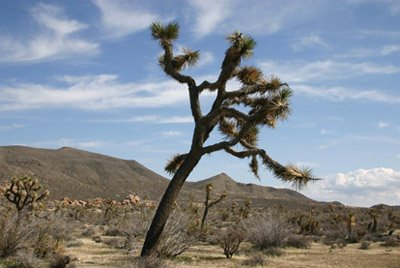Joshua Tree (Yucca brevifolia)

The Joshua tree has become an important symbol of the Mojave Desert. Named after the biblical figure Joshua by Mormon Pioneers, Joshua Trees grow best at elevations between 2,000 and 6,000 feet, prefer flat or gently sloping terrain, and are usually supplanted on steep hills within their range by black brush and other scrubs. The largest specimens can be massive, over 32 feet in height with a trunk circumference of 12 feet. They do not have growth rings like true trees, so determining their age can be difficult, one Joshua tree in the Joshua Tree National Park has been estimated to be about 900 years old.
There are two recognized sub species of Joshua trees: Yucca brevifolia brevifolia and Yucca brevifolia jaegeriana. Yucca brevifolia brevifolia are found in the western and southern Mojave Desert and are the largest of the Joshua trees. In addition, they have relatively long leaves and branch only after they have flowered. Look for them in Joshua tree National Park, Yucca Valley, Palmdale and Saddleback Butte State Park. Yucca brevifolia brevifolia is protected by various cities within the High Desert. Yucca brevifolia jaegeriana is found in the eastern Mojave Desert. This species is smaller and tends to be denser, with smaller leaves and can branch before its first flowering. Excellent populations can be found within the Mojave National Preserve. Cima Dome in the Mojave Preserve contains one of the densest and largest populations of Yucca brevifolia jaegeriana in existence.
Germination is associated with abundant winter precipitation. Grazing animals from cows and deer down to small rodents usually eat the young Joshua sprouts, so most trees begin life in the protective canopy of a bush. After several years of growth the dagger like leaves provide protection, and eventually it grows up and out of the protector plant. Mature plants produce white flowers, and a good Joshua tree bloom is one of the delights of the Mojave Desert.
Until the creation of the Mojave National Preserve no population of Yucca brevifolia jaegeriana was protected. Joshua trees are protected under many city and county ordinances, and within the Mojave Preserve.